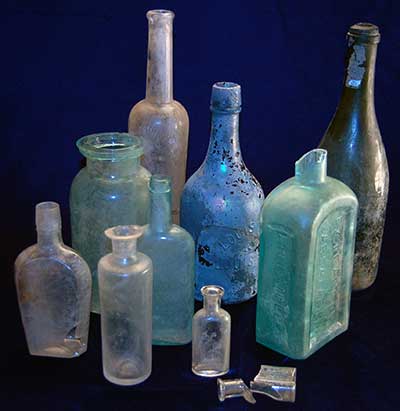Archaeological investigations documented soil layers at Lot 56 that tell the story of the lot's development. They began approximately six feet below the present-day ground surface.
Archaeologists encountered layers of soil that contained artifacts associated with the Mangin house. One of these was a distinctively burned layer that included charcoal and burned artifacts, testimony to the 1856 fire. Several feet of fill and debris covered the Mangin house deposits. Above this fill were layers associated with the construction, occupation, and demolition of the Veit’s shotgun house.
Mangin household artifacts included fragments of burned ceramic dishes, bottle glass, and smoking pipes. These were in the house when it burned in 1856. Mangin ceramics were typical of the 1840s and 1850s: undecorated dishes and examples of mocha and transfer-printed decorated dishes. Other artifacts consisted of nails and window glass fragments.
Veit Family artifacts were reflective of the 1870s to early 1900s. Ceramics were mainly undecorated white granite and whiteware, the most common types of the period, as well as porcelain. Some decorated ceramics included late transfer-printed examples and handpainted and decal-decorated types. Investigators recovered large quantities of bottle glass from the Veit Family deposits, especially from the privies: wine, liquor, medicine, pickle, and condiment bottles.
Animal bones from one of the Veit privies revealed that the family preferred chicken over other meats. Other artifacts associated with the Veit’s shotgun house included mainly nails and fragments of window glass and brick.
 Artifacts from Lot 56 show that despite their rather modest incomes, the Mangin and Veit families readily participated in the nineteenth century's consumer economy. Both families could afford to purchase at least some of the more popular and expensive dishes of the day. The artifacts also show that a wide variety of goods were available to the residents, which demonstrates Portland’s importance as an Ohio River port. Just about anything was available to the residents of Portland.
Artifacts from Lot 56 show that despite their rather modest incomes, the Mangin and Veit families readily participated in the nineteenth century's consumer economy. Both families could afford to purchase at least some of the more popular and expensive dishes of the day. The artifacts also show that a wide variety of goods were available to the residents, which demonstrates Portland’s importance as an Ohio River port. Just about anything was available to the residents of Portland.